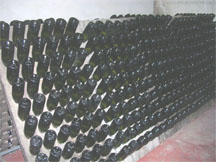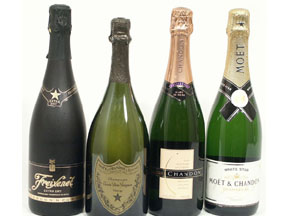With New Years just over, the yearly task of choosing bubbly was once again an international dilemma. Although Champagne is the most common sparkling wine for breaking in the new year, there are others choices that can be quite interesting. Prosecco from the Veneto area of Italia, Francacorta from Lombardia, Cava from Spain, the choices are endless. But what makes each so special? And how do you decide which one to drink? Lets look at two methods using two of the most known sparkling whites. Prosecco vs. Champagne.
First they are made from different grapes. Prosecco is made from the semi aromatic prosecco grape, grown in the hills of Conegliano-Valdobbiadene (an area about 45 min north of Venice), and Champagne, grown in, well Champagne, and is either made completely from chardonnay grapes (as in the blanc de blancs) or a mix of chardonnay, pinot noir and pinot meunier. Next, they are made in two different modes.
Champage is a classic, and probably one of the oldest sparkling wines. The method, called Champenoise, or just classic method, has been carried down by generations, and it is no easy process. First it follows the normal fermentation process and creates a so-so dry wine. Next, the wine is bottled, then sugars and yeasts are added (called liqueur de tirage) to start a second fermentation. The bottles are capped and placed in a pupitre.

This is an upside down ‘V’ shaped piece of furniture which has holes cut into it to support the champagne bottles. The bottles are places horizontally into the lowest level (closest to the floor) and every so often they are moved up the pupitre until they reach the top and are almost vertical. At this point, the fermentation has finished and what is left other than the carbon dioxide (aka bubbles) is a thin film of dead yeast cells sitting at the top of the bottle. The neck of the bottle is then frozen, uncapped and the dead yeast comes shooting out (degorgement). Before the bottle is recapped sometimes extra sugar is added (liqueur d'expedition) therefor giving champagne its character ex. brut, dry, extra dry. The bottles are then allowed to sit for a bit then shipped off to your local restaurant.
The process called Charmat or Martinotti, which is what is used to make prosseco, is quite simple, and one of the reasons it costs much less! After it is made into a still wine, it is moved into huge steel vats which are sealed tight. Yeasts and sugars are added, and the pressure in the vat is turned up. This causes a second fermentation and in the end, bubbles. After a short while, you have sparkling prosecco, ready to be bottled. So short in fact the the bottles must be commercialized within 6 months after the making. The pressure inside the bottle is much less then that of Champagne, only 3 atm (atmosphere) whereas the latter has 6 atm, therefor the bubbles are less, lighter and somewhat bigger in size.
In the end both styles are great and create 2 highly enjoyable but different wines. If your looking for an Italian Champagne, try a Franciacorta... at least the grapes and processes are the same!
